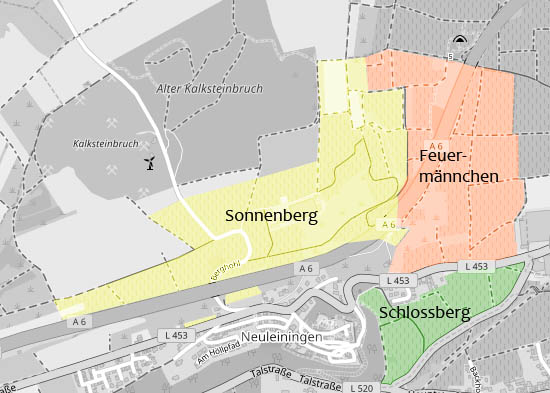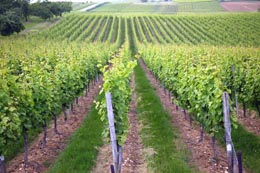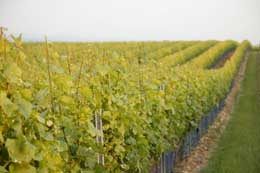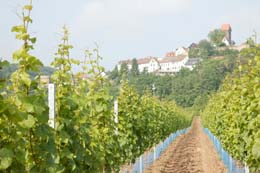Our Sites

Our local proximity to the vineyards, all within 1km reach, is an important asset: a fast grape transport to our cellar is a great advantage we like to use, especially with aromatic varieties.
But still, we find a wide range of climatic- and soil-conditions on a few hundred meters, while the geological boundary between the tertiary limestone rock and Sandstone runs through the village. This must be taken into account in the vineyard work and vinification. See below for more information.
Neuleininger Feuermännchen ("Fireman")

Lime marl, loess and sandstone are the dominant types of soil on this sheltered slope. In the first place, our vineyards are planted here with Riesling-vines. For a good reason: that variety is particularly demanding. Our Riesling vineyards from 1964, but also our youngest from 2015, are cultivated here, as well as Weiss- (Pinot Blanc) & Grauburgunder (Pinot Gris), Chardonnay and Gewurztraminer.
The wines are fast to maturity and take on a strong, distinctive soil character.
Neuleininger Sonnenberg ("Sun Mountain")

Near the plateau, up to 320m above N.N. (that's 140 meters above the "Neuleininger Schlossberg"), there are tertiary, calcareous subsoils, "Muschelkalk" (mussel-chalk), which saves heat quickly and gives off slowly, in the lower layers lime soil dominates the area. The expenditure for vines and winemakers, that the rock brings with it, is worthwhile. The results are mineral, intense, dense wines - especially our red wines grow here, but also Riesling, Grauburgunder and Sauvignon Blanc benefit from this particular site.
Neuleininger Schlossberg ("Castle Mountain")

Sandstone in the west, paired with gravel soils in the eastern part, determine the area below the medevial citywalls. This southern slope is the smallest, and at the same time the warmest of the Neuleiningen Sites.
A low water capacity, combined with high heat storage, are the local soil characteristics. Reduced yield, high maturity and always healthy grapes are the result. Unlike limestone, the sandstone hardly changes the typical varietal character of the wines, so that they appear very clear, straightforward and elegant even at high maturity.